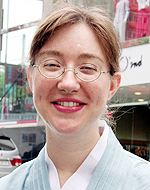[미국불교는 지금] 아이들에게 불교란...법보신문 10. 7. 14
페이지 정보
작성자 관리자 작성일2010.07.19 조회11,194회 댓글0건관련링크
본문
내가 태어났을 때 부모님은 선(禪) 수행공동체에서 살고 있었다. 일반적인 가정생활을 유지하면서 20대 초반의 도반 20여명과 함께 ‘완전한 깨달음’을 위해 금욕적인 계율에 따라 수행에만 집중하는 공동체를 지향했다. 가정생활과 수도자적인 삶의 방식을 결합하는 이러한 시도들과 경험들은 나의 어렸을 적 인성에 커다란 영향을 주었고 그 영향을 기억하는 나에게 ‘자녀를 어떻게 불자로 자라게 할 수 있을까’라는 물음을 불러일으켰다.
일곱 살이 되었을 때 명상 수행실의 한편에 나만의 수행공간을 제공해 주었던 것을 나는 또렷하게 기억한다. 나는 매일 새벽 5시 30분 일어나 이미 30분 동안 명상에 집중하고 있는 어른들과 함께 나머지 30분 동안 명상을 해야만 했다. 터무니없이 이른 새벽에 졸린 눈을 비비면서 일어나 ‘숨 쉬는 것’ 말고는 할 게 없는 면벽 명상에 대해 불평을 했던 적은 없었다.
왜냐하면 공동체의 모두가 다 그렇게 했기 때문이다. 울력 등 수많은 일과와 수행에 관한 경험들은 어린이의 몸과 마음에 불교를 자연스레 스며들게 하는 방법이 무엇인가를 나에게 일깨워주었다. 물론 가정에서 부모님으로부터 많은 것을 배우게 되지만 공동체의 일상적인 문화와 기대는 어린이의 발달에 커다란 영향을 준다. 이런 이유로 나는 일요일마다 큰 딸을 불교 모임에 데리고 간다. 그리고 그곳에서 공동체 생활을 체험하면서 온화하면서도 자신을 성찰할 수 있는 구체적인 방식을 존중하고 실천하는 사람들이 우리만 있는 것이 아니라는 사실을 알아차리게 된다.
새벽 명상시간의 호흡관찰수행은 1분을 못 넘겼지만 때때로 30분간의 명상 수행 중 대부분을 눈을 얼마나 빠르게 깜빡일 수 있는가를 세는데 집중했다. 가끔 ‘지루하다’고 느끼기도 했지만 그래도 독특한 고요함을 체험할 수 있는 이 시간을 좋아했다. 향 내음, 제단 위 촛불의 빛, 부처님의 따스한 미소, 마음을 사로잡는 반야심경 독송 등 명상 수행실의 이런 모습들은 아주 특별한 신성함을 자아냈다. 오늘 다시 그 때의 삼나무 향 내음을 맡는다면 새벽 명상의 신비한 기운이 내면에 되살아나면서 나는 평온과 행복감을 느끼게 될 것이 분명하다. 어린이들은 범종 소리를 들을 때나 다도 의식에 따라 차를 마실 때 놀라게 된다.
그림, 음악, 향기, 음식 그리고 불교와 관련된 이야기들을 어린이들의 섬세한 감각에 연결시킴으로써 어린이들은 비로소 거부감 없이 불교를 만날 수 있다. 마찬가지로 어린이들은 자신들의 신체를 통해서도 영적인 것을 경험할 수 있다. 부모님께서 속해 있던 선 수행공동체에서는 일본의 불교전통을 매우 정교하게 실행했는데 이러한 정교함은 한국불교에서도 마찬가지였다. 실례로 나는 법당에 들어가는 바른 방법에 대해 교육을 받았다. 법당에는 왼발부터 들어서고 법당을 향해 절을 한다. 여러 불단을 향해 향을 사르고 차례로 절을 한다. 어린 나에게 이것은 무의미한 습의 과정이 아니었다. 일곱 살 때 ‘오체투지’하는 법을 배웠고 이후 계속 이를 실수하고 있다. 이제는 몸에 체득되어 저절로 절이 된다. 절 수행은 시련과 고통이 닥쳤을 때 의지처가 되고 있다.
어른들이 거의 온종일 좌선 또는 행선 수행을 하는 안거 기간 중 공동체의 어린이들은 원활한 수행을 위한 도우미가 되었다. 점심 공양 때 다른 한 아이와 나는 좌선 수행 중인 어른들의 발우에 죽을 퍼주기도 했다. 때때로 법당을 청소하거나 ‘좌복’을 정돈하기도 했다. 나에게는 이런 일상들이 공동체 또는 안거 수행의 중요한 부분처럼 느껴졌다.
어른들은 요즈음 자녀들이 집안 또는 불교 공동체의 의식에 적극 참여할 수 있도록 이끌어야 한다는 생각을 하게 됐다. 어린이들은 촛불 켜는 것을 하고 싶어 한다. 명상 수행의 종료를 알리는 요령을 치게 된 10대들은 존중받고 있다고 여긴다. 불교 행사용 포스터 제작에 자신의 컴퓨터 기술이 활용된 것에 대해 대학생들은 자랑스러워한다. 내가 어른이 되었을 때 젊은이들이 수동적이고 움츠린 모습을 종종 보곤 한다. 나의 아들과 딸은 서로 향을 살라 집안의 불단에 올리려고 싸운다.
어린이에게 불교를 가르치는 방법들은 많이 있겠지만 사성제를 암기하고, 법문을 듣게 하는 것은 자연스럽지 못하다. 마치 마른 분필을 먹게 하는 것과 같다. 내 경험으로 알게 된 것처럼 젊은이들은 공동체 속의 일원으로서 다른 구성원들과 맺은 강한 유대 속에서 그들의 감각을 통해, 몸과 마음의 체험을 통해, 예불이나 불교 의식을 함께함으로써 서서히 불자로 거듭난다.
수미런던은
국제불교지도자단(International Order of Buddhist Minsters)에서 계를 수지한 불교 지도자로, 그녀는 미국 노스캐롤라이나주 듀럼에 있는 듀크대학에서 연구에 몰두하고 있다. 현재 듀크에 있는 불교공동체(Buddhist Community)의 지도법사이며 ‘듀럼의 불자가족일요아침모임’(Sunday Morning Buddhist Family Group of Durham)을 지도하고 있기도 하다. 하버드 신학대학원에서 불교학 및 산스크리트어 석사학위를 취득한 후 메사추세츠주 바에 있는 ‘베리 불교학 연구소’(Barre Center for Buddhist Studies)의 부소장을 역임했다. 일본 조동종의 수행 전통에 따라 성장했으나 지난 19년 동안은 주로 남방불교의 위빠사나 수행에 몰입해 왔다. 저서로는『청바지를 입은 부처』(Blue Jean Buddha), 『붓다 그 첫 만남』(Buddha’s Apprentices) 등이 있다.
번역자 백영일 선생은
연세대학교에서 영어영문학을 전공하고 우리은행에 근무하면서 19년 동안 국제금융업무를 전담해 왔다. 특히 2003년 5월부터 11월까지 우리은행 해외지역전문가로 인도에서 6개월간 활동하면서 인도의 문화와 힌두교, 불교문화를 집중적으로 탐방했으며 인도 북부의 다람살라를 방문해 티베트 불교와 현실의 아픔을 직접 보고 느끼고 배우는 데 진력했다. 달라이라마의 대중 법문을 경청하고 티베트의 실상에 대해 탐방하기도 했다. yipaik@wooribank.com
| How Children Experience Buddhism | |
|
| |
|


